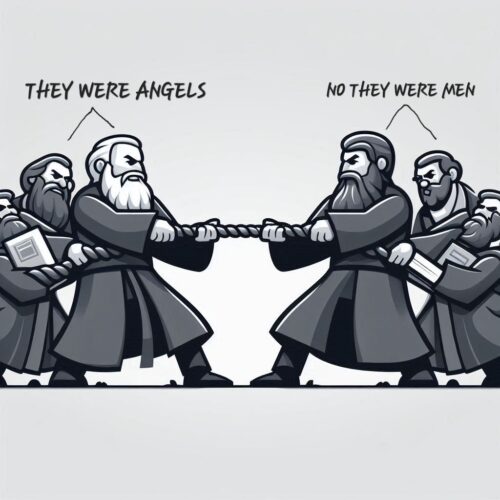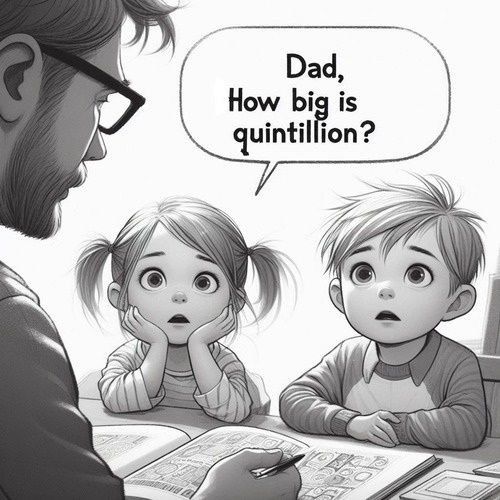Who Are the ‘Sons of God’ and ‘Nephilim’ in Genesis 6?
For centuries, Genesis 6:1-4 has been one of the most intriguing and debated passages in Scripture. The four verses have generated countless discussions, theories, and theological treatises. The passage speaks of “sons of God,” “daughters of men,” and mysterious beings called the Nephilim, setting the stage for the great flood that would soon follow. But what exactly was happening in this cryptic text, and how have the greatest theological minds in church history understood it?
UNDERSTANDING THE TEXT
Let’s begin with the passage itself—Genesis 6:1-4:
The key phrases that demand our attention are “sons of God” (bene ha’elohim in Hebrew), “daughters of men,” and “Nephilim.” The interpretation of these terms, particularly “sons of God,” has divided scholars and shaped our understanding of this passage.
MAJOR INTERPRETATIONS THROUGH HISTORY
Three main interpretations have emerged through church history for Genesis 6:1-4, each with significant scholarly support and biblical argumentation. Understanding these views helps us appreciate the complexity of the passage and the care with which we must approach its interpretation.
The Angelic View: The earliest known interpretation, dominant among Second Temple Jews and early church fathers, is that the “sons of God” refers to angelic beings. The view was held by Justin Martyr, Clement of Alexandria, Tertullian, and later Reformed giants such as Calvin and Edwards.
Strengths:
- Aligns with other biblical uses of “sons of God” (bene ha’elohim)
- Explains the extraordinary nature of the offspring
- Accounts for the severe judgment that followed
- Fits with New Testament references in Jude and 2 Peter
- Was the predominant view in ancient Judaism
Challenges:
- Raises questions about the nature of angels and their abilities
- Seems to conflict with Jesus’ statement about angels not marrying
- Creates difficulties regarding the nature of the offspring
The Sethite View: Popularised by Augustine and widely accepted during the medieval period, this view interprets the passage as describing intermarriage between the godly line of Seth and the ungodly line of Cain.
Strengths:
- Maintains natural created order
- Fits the broader Genesis narrative of two spiritual lines
- Aligns with biblical warnings about believers marrying unbelievers
- Avoids supernatural complications
- Makes clear application to contemporary believers
Challenges:
- Doesn’t explain why such common terms (“sons of God,” “daughters of men”) would be used for this specific situation
- Struggles to account for the extraordinary nature of the offspring
- Must explain why this particular instance of believers marrying unbelievers warranted such severe judgment
The Royal/Ruler View: A third interpretation, less common but still significant, suggests the “sons of God” were ancient kings or rulers who claimed divine status and established harems of women.
Strengths:
- Grounded in ancient Near Eastern context where kings claimed divine status
- Explains the political implications of the offspring being “mighty men”
- Avoids supernatural complications
- Fits with biblical criticism of tyrannical rulers
Challenges:
- Lacks clear biblical parallel for “sons of God” meaning human rulers
- Doesn’t fully account for the severity of judgment
- Has limited support in ancient sources
- Struggles to explain the New Testament references
While the angelic and Sethite views have dominated Reformed thought, neither is without difficulties. The angelic view must explain how spiritual beings could engage in physical relations, while the Sethite view must account for the extraordinary language and consequences described in the text.
THE ANGELIC VIEW IN REFORMED THOUGHT
John Calvin, whose influence on Reformed theology cannot be overstated, firmly held to what we now call the “angelic view.” This interpretation understands the “sons of God” to be supernatural beings who took human wives. Calvin wrote in his commentary on Genesis that those who understand this as merely referring to the sons of Seth “too violently wrest the text.”
The angelic view finds support in several biblical considerations:
- The phrase “sons of God” (bene ha’elohim) appears elsewhere in the Old Testament, particularly in Job 1:6, 2:1, and 38:7, where it clearly refers to angelic beings.
- The New Testament appears to reference this event. Jude 6-7 speaks of “angels who did not stay within their own position of authority, but left their proper dwelling,” linking their sin to sexual immorality. 2 Peter 2:4-5 similarly mentions angels who sinned being cast into hell, placing this in the context of the flood.
- This interpretation explains why the offspring were “mighty men” and “men of renown,” as well as why this incident triggered such severe judgment from God in the form of the flood.
Matthew Henry, Jonathan Edwards, Charles Hodge, and BB Warfield all found this view compelling, seeing it as the most natural reading of the text.
THE SETHITE VIEW: AN ALTERNATIVE REFORMED PERSPECTIVE
The alternative view, known as the Sethite interpretation, understands the “sons of God” to be the godly line of Seth intermarrying with the ungodly line of Cain. This view, popularised by Augustine, has found support among many Reformed thinkers.
The main arguments for the view include:
- It maintains the natural order of creation, where angels are spiritual beings who do not marry (Matthew 22:30).
- It fits the context of Genesis, which has already established the contrast between the godly line of Seth and the ungodly line of Cain.
- It aligns with the broader biblical theme of God’s people being warned against intermarriage with unbelievers.
CRITICAL ANALYSIS
Both views have their strengths and challenges. The angelic view provides a more straightforward explanation of the text and accounts for the New Testament references, but raises questions about the nature of angels and their capabilities. The Sethite view aligns well with broader biblical themes but must explain why the text uses such unusual language to describe what would essentially be believers marrying unbelievers.
THE NEPHILIM QUESTION
The identity of the Nephilim adds a new layer of complexity. The term appears only here and in Numbers 13:33, where it describes giants. Reformed scholars have generally understood them to be extraordinary individuals of great strength and size, though they differ on whether this was due to supernatural parentage or natural causes.
THEOLOGICAL IMPLICATIONS
Regardless of which view one takes, several theological lessons emerge:
- God takes seriously the boundaries He has established in creation.
- Compromise with evil, whether through supernatural or natural means, brings judgement.
- God preserves a faithful remnant (Noah and his family) even amid widespread corruption.
- The passage demonstrates both human responsibility and divine sovereignty in dealing with sin.
CONCLUSION
The fact that such prominent Reformed theologians as Calvin and Hodge could hold the angelic view, while other faithful scholars maintain the Sethite interpretation, should teach us humility in approaching difficult texts. We can hold our views with conviction while maintaining charity toward those who differ.
Genesis 6:1-4 remains one of Scripture’s most fascinating passages. Whether one adopts the angelic or Sethite view, the text clearly warns us about the severity of sin and the importance of maintaining faithful witness in a corrupt world. It reminds us God judges sin while preserving His people, themes that find their ultimate fulfillment in Christ.
The debates over this passage should not distract us from its central message: God’s holiness demands separation from evil, and His grace provides salvation for His people. In our own day, as we face different but equally serious challenges to faithful living, these truths remain as relevant as ever.
THE SONS OF GOD AND NEPHILIM—RELATED FAQS
Could the Nephilim have been the source of ancient myths about demigods? While some have drawn parallels between the Nephilim and ancient myths of demigods, we should be cautious about such connections. The biblical account stands distinct from pagan mythology, describing a historical event that led to God’s judgement rather than glorifying these beings. Reformed theology holds Scripture must interpret Scripture—we must not allow ancient myths to shape our biblical understanding.
- Why does Numbers 13:33 mention Nephilim after the flood if they were destroyed? The term “Nephilim” in Numbers may simply mean “giants” rather than indicating direct continuity with the pre-flood beings. More likely, the spies were using the term metaphorically to emphasise the intimidating size of Canaan’s inhabitants, much as we might call someone a “titan” today.
- How does the Genesis 6 account relate to spiritual warfare? The passage demonstrates an early attempt by spiritual forces to corrupt God’s creation and the Messianic line, whether through direct intervention (angelic view) or through the corruption of God’s people (Sethite view). The episode reveals Satan’s long-standing strategy of attacking God’s redemptive plan through various means, making it relevant to our understanding of spiritual warfare today.
If angels did take human wives, what happened to their offspring when the flood came? Reformed theology generally holds that these offspring, being physical beings born on earth (regardless of their paternity), would have perished in the flood like other humans. Their unique status didn’t grant them spiritual immortality or immunity from God’s judgment, demonstrating that all flesh corrupted by sin faces divine judgment.
- How does this passage inform our view of marriage today? The passage underscores the sacred nature of marriage as established by God within proper created boundaries. Whether one takes the angelic or Sethite view, the text clearly warns against marriages that violate God’s ordained order and demonstrates the severe consequences of such violations for society and subsequent generations.
- What role did the women (“daughters of men”) play in this scenario? Scripture doesn’t assign specific blame to the women, but neither does it present them as helpless victims. The account suggests a mutual corruption where both parties participated in violating God’s created order. It reminds us sin often involves willing participation on all sides, even when power dynamics are unequal.
Does this passage suggest that angels have physical bodies or can take physical form? While angels typically appear as spiritual beings, Scripture records instances where they take physical form to interact with human beings (like the angels who visited Abraham). However, Reformed theologians generally emphasise that even if angels can take physical form, this represents a temporary state rather than their essential nature.
THE SONS OF GOD AND NEPHILIM—OUR RELATED POSTS
Editor's Pick

Faithful to the Pattern: Why Paul Reserves Ordination for Men
Few topics in contemporary Christianity generate more tension than women’s ordination. This question touches real lives, genuine callings, and deeply [...]

‘Flee Sexual Sin’: Why Does Paul Single This Sin Out?
When the apostle Paul writes to the Corinthian church, he doesn’t tell them to simply avoid sexual immorality or resist [...]

Does Denying God’s Sovereignty Mean Denying the Gospel?
RC Sproul once warned denying God’s sovereignty “eviscerates” grace—a strong word meaning to gut or disembowel something, leaving only an [...]

Why Christians Fast: The Biblical Discipline’s Very Real Rewards
Why would Christians, who rejoice in the good gifts of food and fellowship, deliberately choose to go without? Isn’t fasting [...]

The Christian Sabbath: Why Did Sunday Replace Saturday?
Consider this: God-fearing Jews who’d faithfully observed Saturday Sabbath for over a thousand years suddenly began gathering for worship on [...]

Did the Early Christians Worship Jesus? The Biblical Evidence
It was a startling transformation: Jewish fishermen who'd spent three years following this itinerant carpenter from Nazareth now begin to [...]

If Jesus is Messiah, Why Aren’t ALL Messianic Prophecies Fulfilled?
If Jesus is truly the Messiah, why hasn't world peace arrived? Why do Jews still face persecution? Why isn't the [...]

When Courage Fails: Will I Be Forgiven If I Deny Christ in Persecution?
The rooster crowed, and Peter remembered. In that devastating moment, the apostle realised he’d just done the unthinkable—three times he’d [...]

What Makes a Godly Dad? 5 Biblical Principles Fathers Need
Modern culture sends fathers mixed messages. Be strong but sensitive. Be involved but not overbearing. Lead but don’t dominate. With [...]

What Makes a Godly Mom? A Scripture-Backed Guide
In our culture’s confusion about gender roles and parenting, the timeless question remains: what makes a godly mother? While secular [...]
SUPPORT US:
Feel the Holy Spirit's gentle nudge to partner with us?
Donate Online:
Account Name: TRUTHS TO DIE FOR FOUNDATION
Account Number: 10243565459
Bank IFSC: IDFB0043391
Bank Name: IDFC FIRST BANK






